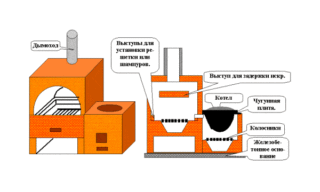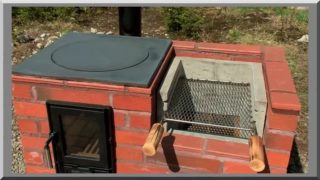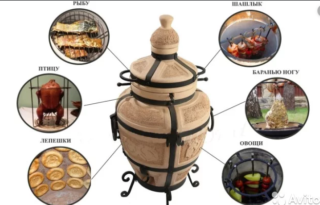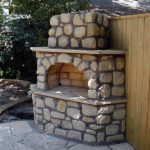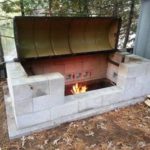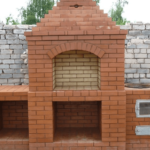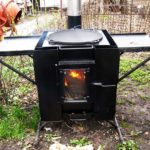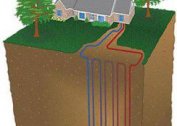A street oven is a great idea for a summer cottage and a courtyard of a private house. The functions of this facility are not limited to just cooking. By setting the hearth on a flat, solid base and equipping it with comfortable furniture, you can get at your disposal a multifunctional platform. The scope of its application is wide, from a place for eating, to holding public events and just having fun in the fresh air. There are many approaches to making a stove on the street for a do-it-yourself summer house. To make the best decision, you need to familiarize yourself with the design of the foci, the materials used and the assembly rules.
What does an outdoor stove consist of
All outdoor stoves for summer cottages have approximately the same device and principle of operation, varying significantly in size and appearance.
Objects consist of such parts:
- Base. Most often, they are served by a concrete slab, which is bought ready-made or cast independently.
- Body. Serves for the location of all nodes and mechanisms inherent in each type of product.
- The combustion chamber. It is made in open and closed execution. Designed to produce heat and smoke due to combustion of fuel.
- Hob. Dishes, products on skewers, skewers or wire racks are installed on it.
- Chimney. The facility is designed to divert combustion products to such a distance where they can not annoy the cook and those present.
Additional accessories include cutting tables, awnings, shelves for storing firewood, coals, dishes and cutlery.
Types of Outdoor Stoves
When choosing a stove model on the street, many factors should be taken into account, the main of which is the purpose and performance of the product. It is necessary to summarize the taste priorities of all residents of the house and their possible guests, and then make a decision. In addition, you need to evaluate your construction skills and financial capabilities so as not to stretch the construction for several years.
Russian stove
A Russian brick stove on the street looks beautiful if it has an environment that is appropriate for its size. It is necessary to think over questions of arrangement of the platform with tables and benches in advance. A canopy is made without fail, since from getting wet the clay between the bricks becomes soft.
Russian oven can be used for cooking, frying and smoking. If you correctly think about the configuration of a removable hob, the hearth is suitable for cooking barbecue.
Since the structure is not intended for heating, it is covered with insulating materials from the outside. The finish must be durable and waterproof. Depending on the size, 2500-3500 bricks will be required for the construction of the furnace.
Stove with hob
This is a simple design, not distinguished by originality and functionality. The choice in favor of the brewing-type hearth is made in those cases when the dacha is visited occasionally for work in the garden and vegetable garden, and the stove is used to heat food and water for taking a bath.
The best option is to use for the assembly of thick sheet steel or cast iron. The top of the hearth is wide and flat for the convenience of placing dishes. The functionality of the boiler is expanded by welding metal plates on the edges of the casing to dry clothes. So that the product does not become a victim of scrap metal hunters, it is made in a portable version or welded to mortgages embedded in the foundation.
BBQ
This is a classic that is associated with life in the private sector. Brazier is made in the form of a rectangular container. In its lower part, holes are made for air flow, and along the upper edges of the slot for skewers. In production, metal with a thickness of at least 6 mm is used to withstand the intense heat emanating from coal.
The base of the structure can be in this design:
- embedded in concrete;
- on legs;
- on wheels;
- on the runners.
Despite the fact that the summer barbecue is originally intended for cooking barbecue, it can be successfully used for cooking in a cauldron, pan and pan. To do this, coasters are made, which are fixed on the upper part of the hearth. Thanks to such a simple solution, a small product becomes functional, replacing complex and bulky kitchen complexes.
B-B-Q
Barbecue are simple in design and versatility in use. On a wood hearth you can cook, smoke, bake and fry. The body is laid out of brick, a firebox is made below, and on top is a platform for placing dishes, wire racks, skewers and skewers.
Making such a street brick stove with your own hands is not difficult. It looks great both against the background of the Finnish house, and next to the building made of timber. The functionality of the structure can be improved by making shelves for food and utensils.
Tandoor
The stove is laid out of refractory bricks or stone. The finished structure has the shape of a jug and looks quite exotic, without spoiling the design of the site. Some craftsmen use an iron barrel to make a tandoor, coating it inside and out with several layers of clay. To prepare various dishes, not only the neck of the vessel is used, but also its walls, on which the cakes are laid.
A cauldron is installed on top of various supports, lattices and other devices are laid. Heat treatment of products in the tandoor occurs due to the heat that is released from the heated walls.
Fireplace
Properly and tastefully built fireplace performs the functions of heating, roasting and decorating the site. In most cases, such structures are placed in enclosed gazebos. A grill is installed above the firebox, serving as a stand for dishes, grills and skewers. Fireplaces are made of stone, brick or metal, followed by facing with decorative material.
DIY building materials
To build a furnace on the street, you must choose a material that has a number of qualities necessary to create a strong and durable structure. The focus should be resistant to high and low temperature, moisture and ultraviolet.
There are the following options for choosing material for construction:
- Brick. Time-tested method. The brick hearth looks great anywhere. Its walls quickly warm up and retain heat for a long time. The work uses heat-resistant products that can withstand heat up to +1000 ° C without damage. To protect the structure from moisture, special plaster or ceramic tile is used. In order not to make a mistake in choosing a cladding, you need to carefully read the manufacturer's instructions.
- Aerated concrete. The advantage of the blocks is their lightness and large size. For the hearth there is no need to equip a powerful and expensive foundation. The disadvantage is the hygroscopicity of aerated concrete. It must be isolated both from the outside and from the inside.
- Natural stone. Dolomite paving stones are used in construction; cracks are filled with chamotte clay with granite crumbs. Finished buildings do not need finishing, have a representative appearance, are characterized by strength and durability.
- Metal. Iron furnaces can be easily made on the basis of the simplest home-made drawing and with a welding machine. To assemble the hearth, sheet metal or workpieces from suitable structures are used.Iron is distinguished by its strength, lightness, and the possibility of forging decoration and multiple modifications. The downside is that the walls of the furnace rust and gradually thin out.
- A rock
- Aerated concrete
- Brick
- Metal
When choosing a material, one should not forget about its aesthetics, so that the finished structure organically fits into the surrounding landscape.
Place selection
Drafting begins with the attachment of the outbreak to a site on the site. The best option is to place it next to a previously built gazebo, canopy or terrace. If the arrangement of the yard is carried out from scratch, the stove should be assembled at the maximum distance from the house, in order to exclude the possibility of smoke and fire.
You need to locate the hearth at a distance of at least 1 m from the fence, shed, garage and other combustible buildings. There should not be trees and bushes near, and underground utilities under the stove. If there is such an opportunity, you should build a hearth on the leeward side of the house. It is also recommended to provide for the future availability of space for the site, tables, benches and chairs.
Masonry stove
A do-it-yourself garden stove is assembled on the basis of a well-thought-out scheme, on which the order is indicated, all the components of the structure are shown in detail.
Furnace Walkthrough:
- Land clearing and marking.
- Digging a pit.
- Creating a pillow of sand and gravel.
- Production of formwork.
- Bookmark the frame of the reinforcement.
- Foundry casting.
- Laying waterproofing.
- Laying out the base, blower and smoke ducts.
- Firebox installation.
- Securing the hob.
- Installation of the chimney.
- Finishing work.
After drying and shrinkage of the solution, the first furnace is carried out at a low temperature.
